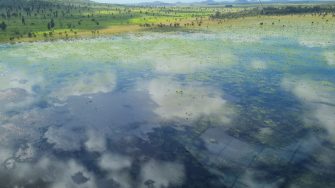
Date: Friday, November 19, 2021
Project: Eastern Australian Waterbird Survey
Observers: John Porter & Richard Kingsford
Pilot: Tim Dugan
It was about 20 minutes from Gladstone to the Fitzroy River near Rockhampton - up the coast and then along the river and floodplain of the Fitzroy River.
Amazing patterns made by the delta fingers of the Fitzroy River.
We flew up the Fitzroy River with its floodplains to just north of Rockhampton. Unlike our other aerial surveys, we had added another leg to this Queensland section this year for the Queensland Government – a survey of the wetlands adjacent to the Great Barrier Reef. We started this part of the survey just north of Rockhampton but then back southeast across the floodplain.
The Fitzroy River running through Rockhampton.
Surveying the lagoons of the Fitzroy River.
There were plenty of lagoons but not many of them were full and quite a few completely dry. They had a few waterbirds but not as many as we expected. There were pelicans, some white pygmy-geese and the usual waterbirds in their tens: black swans, black duck and various cormorant species. We were also starting to see a few wandering whistling-ducks (also called grass whistling-ducks).
Fitzroy River lagoons.
It took us quite a while to survey all these wetlands, many quite close to Rockhampton airport, but we had good support from the air traffic controller. From here we headed down to the mouth of the river, to the estuary.
Moving on from the freshwater lagoons to surveying more saline wetlands down near the Fitzroy River estuary.
Fitzroy River estuary.
We then headed north along the coast, surveying the very picturesque lagoons along the coast with their palm trees. They mostly had egrets, swans and black duck.
Surveying the coastal lagoons north of the Fitzroy River
Palm lined lagoons along the coast.
One of the larger floodplains.
We then surveyed wetlands on the eastern part of Band 9, close to the Styx River.
Styx River estuary.
This was the driest we had seen this part of our usual survey band with very few of the dams or ponded paddocks with any water.
An almost dry ponded paddock, near the Styx River.
It'd already been a long day so we landed for a leg stretch around here on a council airstrip. And then we headed north, surveying various lagoons all the way up the coast.
We had been flying for a fair while and so had to stop in Mackay to refuel.
Train loaded with coal for the ports.
We then reached the Proserpine River floodplain, which is on our survey band 10. We zigzagged our way across the area. It was dry, apart from a couple of the large dams.
There were few lagoons with any water. Certainly, a lot less than used to occur here. Egrets, pelicans, magpie geese and black duck were the most common waterbirds. It was also nice to see the odd jabiru.
Surveying one of the Proserpine River floodplain wetlands.
From here we kept on going north. There were quite a few small wetlands along the coast but a fragment of what used to occur here before floodplains were developed for sugar cane.
A degraded wetland area.
One of the larger prawn farms on the coast.
From Bowen, we flew past the Abbott Point Coal Port and surveyed the Cayley Valley wetlands. They had limited flooding and just a few waterbirds but some migratory species.
Surveying the Caley Valley wetlands.
We crossed the Burdekin River and flew up to its floodplain.
The wetlands behind Bowling Green Bay were extensive and we were really flat out. Here there were large flocks of magpie geese, egrets and swans. There were also quite a few small flocks of brolgas. There were long periods of intense surveying and so we stopped for a welcome break at Ayr before resuming.
One of the large flocks of magpie geese.
Surveying the Burdekin floodplain.
For a couple of hours, we went back and forth across this floodplain. Even though it was hard work, it was just great to see such extensive areas. These must have once extended right across the floodplain before sugarcane areas took over.
Surveying more wetlands on the Burdekin floodplain.
There were many hundreds of egrets and huge flocks of 100 or more magpie geese. And then, scattered in among these, there was the odd jabiru. And at times they were clouds of black duck. Not many grey teal. And of course, lots of pelicans and swans and small flocks of white pygmy-geese.
It was a long day by the time we reached Townsville. We still had to present ourselves to the Queensland Police at the airport for a check of our border passes. It had been a long but rewarding day - about nine and half hours flying.
By Richard Kingsford
